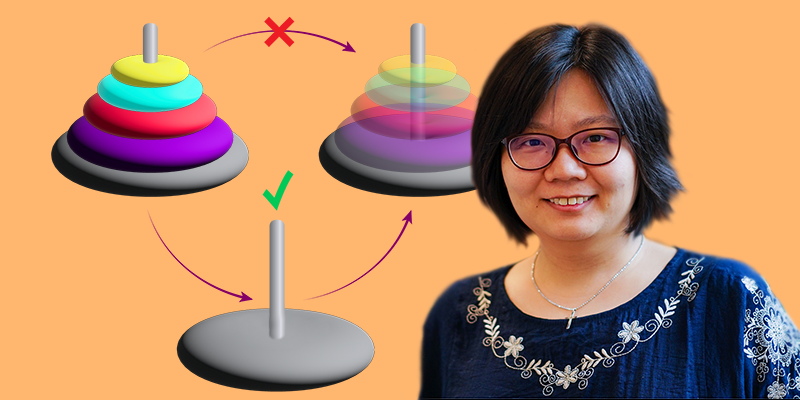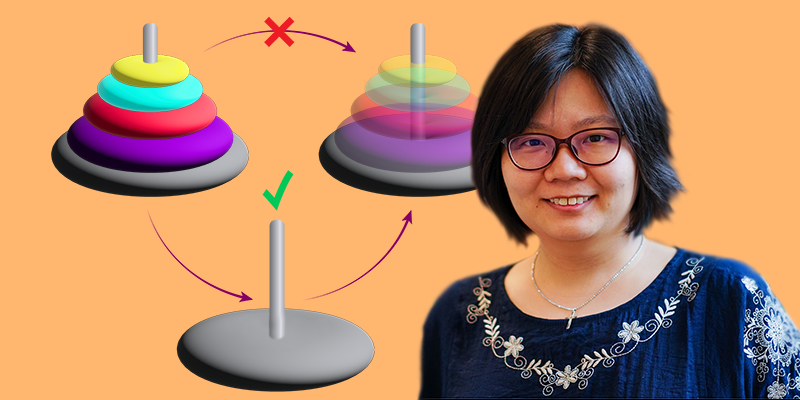“Catalyzing” Quantum Information
Getting the most out of a quantum device is not easy. Boosting the performance of a quantum computer, for example, can require wiring in a packet of new quantum gates or investing in extra qubits. One way to think about those additional resources is to consider them as “catalysts” that can drive a quantum process in a way analogous to how an enzyme drives a biochemical process. Nelly Ng, a quantum information theorist from Nanyang Technological Institute in Singapore, studies quantum catalysis in the realm of quantum thermodynamics, but she says the topic is wide ranging, applying to quantum cryptography and quantum networks. “Quantum catalysis is a growing field because there are still so many unanswered questions and different directions it can take,” Ng says.
To help navigate the quantum catalysis landscape, Ng has written a comprehensive review with collaborators Patryk Lipka-Bartosik from the University of Geneva and Henrik Wilming from Leibniz University Hannover, Germany [1]. They hope that this summary will catalyze future developments in quantum information applications. Physics Magazine asked Ng about her catalysis work and about why her group members go by the name “inQlings.”
All interviews are edited for brevity and clarity.
What got you interested in quantum information?
When I first started as a physics student, I struggled to understand quantum theory, as the concepts seemed counterintuitive and hard to relate to everyday experience. But then I did some research on quantum cryptography, and I was struck by the real-world implications of quantum physics. You can design a quantum operation protocol that makes a communication network 100% secure from hackers. I didn’t stay in quantum cryptography, but I remained hooked on the synergy between quantum physics and information theory.
And when did you start focusing on quantum catalysis?
I started thinking about quantum catalysis around ten years ago. My entry point was through quantum thermodynamics, but I was intrigued by the relevance of catalysis in other fields of quantum information. In fact, Patryk, Henrik, and I work on very different types of problems, but we found common ground in viewing these problems through the lens of catalysis. We decided to write a review that would bring together all these different types of catalysts, like assembling pieces of a puzzle to form a full picture.
Can you explain the name of your group?
My group in Singapore is called in.Q, where “in” stands for information theory and “Q” for quantum. Besides being the focus of our research, the name also fits with my philosophy for the group, which is to prize the spirit of inquiry. Group members are playfully called inQlings, which is a nod to the Inklings, a group of literary enthusiasts in Oxford, UK, who were active from the 1930s to the 1950s.
How might you describe quantum catalysis to a nonexpert?
In our everyday experience, we often turn to some additional object or process that enables us to perform a certain task. It becomes catalytic when this additional resource can be reused over and over. Catalysts are familiar in biology in the form of enzymes—protein agents that facilitate a chemical reaction. These enzymes return to their original state at the end of the process, so they can be used repeatedly.
When we start thinking about the quantum regime, we can also have catalysts that operate in a repeating loop. A common example is an auxiliary (or ancilla) qubit that helps perform a computation by, for example, acting as a “middleman” in the entanglement of two other qubits. This extra qubit doesn’t retain valuable information, so it can be returned to its initial state after the computation. Other examples of quantum catalysts are atomic clocks and optical cavities.
In your review, you compare quantum catalysts to the Towers of Hanoi. Can you explain that analogy?
We wanted to explain the catalytic advantage in a simple way, and we hit upon the Towers of Hanoi, which is a famous brainteaser in which you have to move a set of stacked rings from one rod to another rod. The rules are that you can only move one ring at a time, and you can’t place a larger ring on top of a smaller ring. There’s no way to solve the puzzle with only two rods, but you can solve it if you have a third rod. That extra rod is like a catalyst, as it enlarges the working space so that you can make moves that were not possible before. The same is true for quantum catalysts—they let you process information in ways that bypass the physical constraints of the system.
What does your work with quantum catalysts entail?
We take a very general approach. There is a mathematical framework that allows us to derive functions called “monotones,” whose behavior tracks how an initial state transforms into a final state. By studying the properties of these monotones, we can explore whether a catalyst can offer an advantage in some quantum information process. We can also address the larger question: Is this catalyst worth the extra effort or cost of adding qubits or other hardware?
What is the future of quantum catalysis?
Currently, our work is primarily theoretical. But researchers could eventually analyze real-world quantum computers and ask whether a catalyst could simplify a particular algorithm. Perhaps it could reduce the number of gates or minimize the effect of errors. I think the future is very open as to what advantages can be gained within the framework of catalysis.
–Michael Schirber
Michael Schirber is a Corresponding Editor for Physics Magazine based in Lyon, France.
References
- P. Lipka-Bartosik et al., “Catalysis in quantum information theory,” Rev. Mod. Phys. 96, 025005 (2024).





